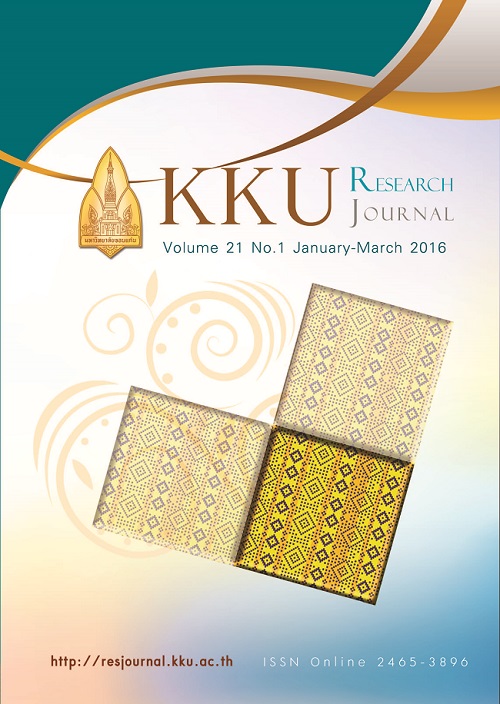Decomposition, nitrogen release and soil fertility of plant residues incorporation from different pre- sugarcane planting management
Main Article Content
Abstract
The effect of decomposition, nitrogen release and soil fertility of upland rice-legume residues incorporation before sugarcane planting was investigated. The experimental design was randomized complete block design (RCBD) with 4 replications. The following residue and control treatments were implemented: i.e. i) control; no residues incorporation, ii) weed, iii) soybean (Glycine max), iv) sunn hemp (Crotalaria juncea) and v) upland rice. Soil samples and litter bags were collected at 1, 2, 4, 8, 12, 16, 24 and 32 weeks after incorporation. Soil mineral N was analyzed by Flow Injection Analyzer (FIA) and remaining dry weights of litter bag were recorded. Soil microbial biomass was measured by chloroform fumigation extraction method. The results revealed that weed residues treatment had the highest of remaining dry weight and % N remaining in litter bag in most sampling dates. Sunn hemp residues treatment had the highest soil mineral N and was significantly different from the other treatments (p < 0.01) at 4, 8, 12 and 16 weeks after residues incorporation. At final sampling date, the upland rice residues treatment gave the highest microbial biomass N and was significantly different from the other treatments (p < 0.01) and provided the highest relative microbial biomass N but not significantly different from soybean residues treatment. Moreover, soil organic matter could be improved by all residue treatments. However, sunn hemp may be a potential crop for soil N release but upland rice could support rice consumption demand. Thus, the effect of legume-upland rice residue incorporation on sugarcane yield should be further investigated under field conditions.
Article Details
References
residue decomposition and N2 fixation of grain legumes upon sugarcane residue retention as an
alternative to burning. Soil and Tillage Research 99: 84-97.
[2] Whitmore AP, Cadisch G, Toomsan B, Limpinuntana V, Noordwijk MV, Purnomosidhi P. 2000. An analysis
of economic values of novel cropping systems in N.E. Thailand and S. Sumatra. Journal of the Royal Netherlands Society for Agricultural Sciences 48: 105-114.
[3] Toomsan B, McDonagh JF, Limpinuntana V, Giller KE. 1995. Nitrogen fixation by groundnut and
soybean and residual nitrogen benefits to rice in farmers’ fields in Northeast Thailand. Plant Soil 175:
45-56.
[4] Shoko MD, Zhou M, and Pieterse PJ. 2009. The use of Soybean (Glycine max) as a breake crop
affect the cane and sugar yield of sugarcane (Saccharum officinarum) variety CP 72-2086 in Zimbabwe.
World Journal of Agricultural Sciences 5 (5): 567-571.
[5] Yadav RL. 1995. Soil organic matter and NPK status as influenced by integrated use of green manure,
crop residues, cane trash and urea N in sugarcane – based crop sequences. Bioresource technology
54: 93-98.
[6] Vityakon P, Meepech S, Cadisch G, Toomsan B. 2000. Soil organic matter and nitrogen transformation
mediated by plant residues of different qualities in sandy acid upland and paddy soils. Journal of
the Royal Netherlands Society for Agricultural Sciences 48: 75-90.
[7] Kaewpradit W, Toomsan B, Cadisch G, Vityakon P, Limpinuntana V, Saenjan P, et al. 2008. Regulating
mineral N release and green house gas emissions by mixing groundnut residues and rice straw under field
conditions. European Journal of Soil Science 59: 640-652.
[8] Tecator. 1984. Determination of ammonium nitrogen (A S N 65-32/84) or nitrate nitrogen (ASN
65-31/84) in soil sample extractable by 2 M KCl using flow injection analysis. Application notes.
Tecator, Höganas, Sweden.
[9] Amato M, and Ladd JN. 1988. Assay for microbial biomass based on ninhydrin-reactive nitrogen in
extracts of fumigated soils. Soil Biology and Biochemistry 20: 107-114.
[10] Melillo JM, Aber JD, and Muratore JF. 1982. Nitrogen and lignin
control of hardwood leaf litter decomposition dynamics. Ecology 63: 621–626
[11] Heal OW, Anderson JM, and Swift MJ. 1997. Plant litter quality and decomposition: An historical
overview. (eds Cadisch G & Giller KE), pp. 3-30. CAB International,Wallingford, UK.
[12] Taylor BR, Parkinson D, and Parsons WFJ. 1989. Nitrogen and lignin content as predictors of litter
decay rates: A microcosm test.Ecology 70: 97-104.
[13] Hammel KE. 1997. Fungal degradation of lignin. In: Driven by nature: Plant residue Quality and
Decomposition (eds Cadisch G & Giller KE), pp. 33-46. CAB International, Wallingford, UK.


